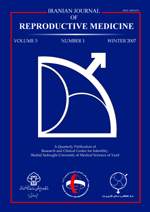
|
International Journal of Reproductive BioMedicine
Research and Clinical Center for Infertility, Shahid Sadoughi University of Medical Sciences of Yazd
ISSN: 1680-6433
EISSN: 1680-6433
Vol. 16, No. 11, 2018, pp. 689-696
|
 Bioline Code: rm18084
Bioline Code: rm18084
Full paper language: English
Document type: Research Article
Document available free of charge
|
|
|
International Journal of Reproductive BioMedicine, Vol. 16, No. 11, 2018, pp. 689-696
| en |
Association of serum content of 25-hydroxy vitamin D with semen quality in normozoospermic and oligoasthenoteratozoospermic men
Azizi, Elham; Naji, Mohammad; Shabani-Nashtaei, Maryam; Sobhani, Aligholi; Najafi, Atefeh & Amidi, Fardin
Abstract
Background: Vitamin D has multifaceted function in human reproductive
physiology. It has been revealed that vitamin D is involved in spermatogenesis, and
semen quality can be linked to vitamin D status in men.
Objective: Evaluating the correlation of 25-hydroxy vitamin D (25-OHD) levels in
serum with basic and advanced semen parameters and essential determinants of
spermatozoa function.
Materials and Methods: Participants were categorized, based on semen parameters,
into normozoospermic (NS) and oligoasthenoteratozoospermic (OAT) men. Serum
level of 25-OHD was measured. Apoptotic status of spermatozoa, mitochondrial
membrane potential and reactive oxygen species content of semen were assessed.
Results: Difference of 25-OHD concentration in serum of NS men versus OAT ones
did not meet significance threshold. DNA fragmentation, reactive oxygen species
content of semen and mitochondrial membrane potential state revealed significant
difference between NS and OAT subjects. There were no significant differences in
basic and functional semen parameters when men were stratified based on serum 25-OHD level. Taking both 25-OHD and semen categories (NS and OAT) into
consideration did not indicate any significant difference in studied parameters. Total
motility of spermatozoa was positively correlated with serum concentration of 25-OHD in all studied subjects. In addition, normal morphology of spermatozoa in NS
men revealed a positive and significant correlation with levels of 25-OHD in serum.
Conclusion: Vitamin D may affect motility and morphology of spermatozoa. Lower
content of serum vitamin D may affect fertility of men and should be considered in
examination of men with abnormal spermogram.
Keywords
Vitamin D; Infertility; DNA fragmentation; Reactive oxygen species; Semen analysis.
|
| |
© Copyright 2018 - International Journal of Reproductive BioMedicine
Alternative site location: http://www.ijrm.ir
|
|
